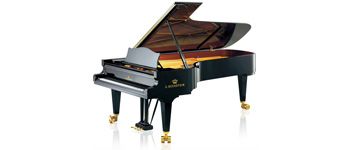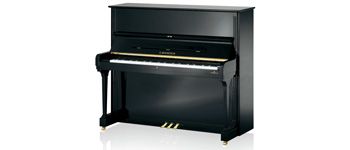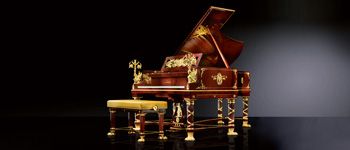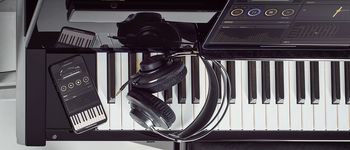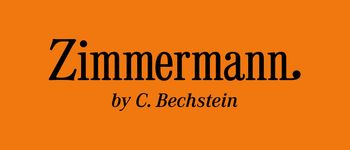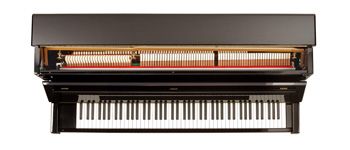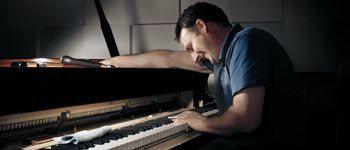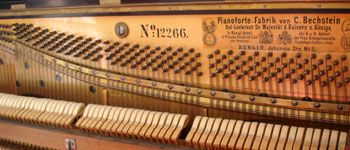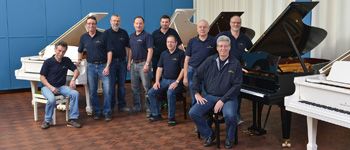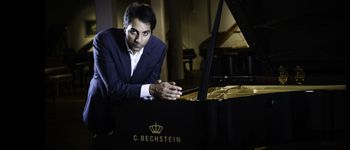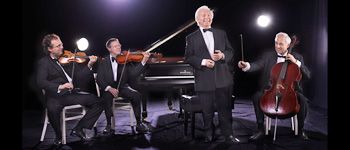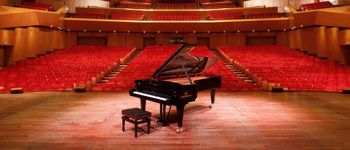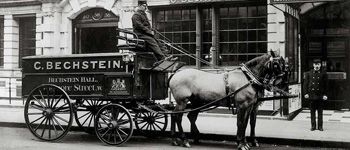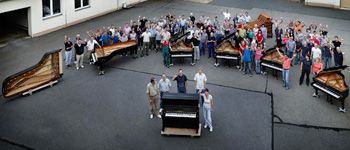Bechstein-Moór duplex grand piano
In 1929, Bechstein launches a truly novel instrument developed in collaboration with the Hungarian pianist and inventor Emánuel Moór: the Bechstein-Moór piano. Just like an organ, this “monstrosity” has two keyboards, the second an octave higher than the first. According to Moór, the instrument is ideal for playing Bach. The invention arouses curiosity — and is a commercial disaster.
Neo-Bechstein grand piano
Another invention could be more successful as it is clearly futuristic. This ancestor of today’s digital pianos is developed in collaboration with Walther Nernst, Nobel laureate in chemistry in 1920, who is considered the founder of modern physical chemistry. Nernst is primarily famous for establishing the Third Law of Thermodynamics, which deals with temperatures near absolute zero, and for inventing a bulb that emits white light. Siemens & Halske supplies the electrotechnical components of the novel piano, so that the instrument is called by some the “Siemens-Nernst piano” and by others, the “Neo-Bechstein.” On this 1.4-meter grand piano without soundboard, groups of five strings are placed under microphones that convert the vibrations produced by “micro-hammers” hitting the strings into electrical signals. The right pedal controls the volume, while the left one generates either “cembalo” or “celesta” sound. The instrument is fitted with a radio and a turntable, both of which use the integrated amplifier and loudspeaker. Oskar Vierlin, one of the most inventive piano-makers of the early 20th century, is entrusted with the making of the Neo-Bechstein’s conventional components.
C. Bechstein, a company that had co-operated with a great pianist in the mid-19th century, now collaborates with a Nobel laureate, which says a lot about the company’s philosophy. In 1931, the technology magazine Signalen writes: “On 25 August, Professor Nernst presented the Bechstein-Siemens-Nernst piano before numerous guests who gathered at the Bechstein showroom near Berlin’s Zoo Station. The novel instrument is surprisingly versatile, as it is even provided with a radio and a loudspeaker.”
But despite its sensational features, the new piano model is another commercial disaster. This is quiet surprising as it is suitable for broadcasting and recording without external microphones — and even cheaper than the smallest Bechstein upright of the day. The reason might be that the Neo-Bechstein is too far ahead of its time: the market for electronic pianos, while considerable today, barely occupies a niche in the early 1930s. When Nernst dies in 1941, all his calculations for this ground-breaking instrument are lost forever.
British commercial from 1933 featuring Peggy Cochrane playing the Neo-Bechstein grand piano
Helene Capito, a disaster for Bechstein
In the aftermath of the Wall Street Crash of 1929, a severe worldwide depression hits Germany by late 1932, prompting Bechstein to develop new marketing strategies. Some instruments are then described as “made with a considerable, yet provisional, reduction of manpower”. This does not help much: Bechstein sells only some 4500 pianos between 1930 and 1935, and production drops as low as 3900 in the next five years. This demonstrates once again that the company does not benefit from Helene Bechstein’s, née Capito, admiration of Adolf Hitler.
In the same period, the company’s internal situation is particularly uncomfortable. In 1926, new conflicts tear apart the “Bechstein clan”, in particular because of the new showroom at the crossroads Kurfürstendamm/Hardenbergstrasse, one of Berlin’s most posh and expansive locations, right in front of Emperor William Memorial Church. The building is a work by Hans Poelzig, the architect who modernised the Schauspielhaus theatre on behalf of Max Reinhard, built Berlin’s Broadcasting House and the headquarters of IG Farben in Frankfurt, and drew the plans of a futuristic building for the Salzburg festival, which was never built. Carl Bechstein Junior, who had the idea of the new showroom, has to face the opposition of his brother Edwin, who ultimately leaves the company. Henceforth, the board of directors is composed of Carl Junior and his son Carl III (who joined the board in 1919), Hans Joachim Gravenstein (Grete Bechstein’s husband), and Erich Klinkerfuss. Carl Junior dies in 1931, Edwin in 1934.
Of course, the company endeavours to adapt to the structural changes of the market. In 1926, Bechstein launches the Liliput, a grand piano with a length of only 165 centimetres. In the early 1930s, the London subsidiary, which reopened in 1924 as “Bechstein Piano Company Ltd,” produces an even shorter grand piano (138 centimetres) to match the small dimensions of British living rooms. This production was stopped in 1940. Instead, the Berlin factory produces a 140-centimeter grand that is also tailored to the needs of the British middle-class and sells in London for the equivalent of 630 marks, nearly fifteen times as much as the weekly wages of a Bechstein worker. By this time, Selfridges (Oxford Street) and Harrods (Brompton Road) are selling Bechstein pianos, and the latter department store even markets them in its six subsidiaries in Argentina. Nonetheless, sales in Great Britain suffer from the anti-German sentiment that is to grow after Hitler seizes power in 1933.
That year is a disaster for C. Bechstein, as sales collapse. The company is restructured the next year and Helene Bechstein becomes the main shareholder. In order to increase the capital stock, she decides to sell the real estate on Johannisstrasse to the Prussian state — whose Minister-President is nobody else than Air Field Marshall Hermann Goering. We do not know exactly to what extent Helene Bechstein’s dealings with high-ranking Nazi personalities has a positive influence on the sale of the real estate. We can only repeat that her attitude did not in any way boost the sales of pianos, nor the activity of the company’s Propeller department.
On the contrary, Bechstein loses a substantial number of its traditional customers through the persecution and expropriation of the German Jews, followed by their deportation and murder in the Nazi camps, as having a Bechstein in one’s living room was a must in well-to-do Jewish families before the war. And what happened to the instruments left in Germany by people who emigrated or were deported? According to the terminology of the Nazi administration, they were considered “Jewish property without proprietor” — and were stolen during the looting of the abandoned apartments. We do not know, for example, what became of Artur Schnabel’s two grand pianos, nor the instruments used by the composers Ralph Benatzky and Jean Gilbert. Moreover, after the Second World War, most of the musicians who emigrated permanently turned their backs on what had been their favourite piano brand before the Holocaust.
